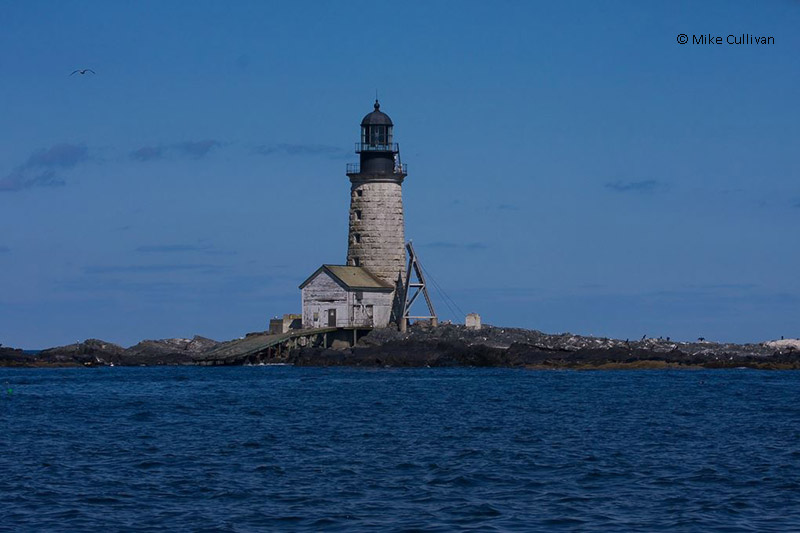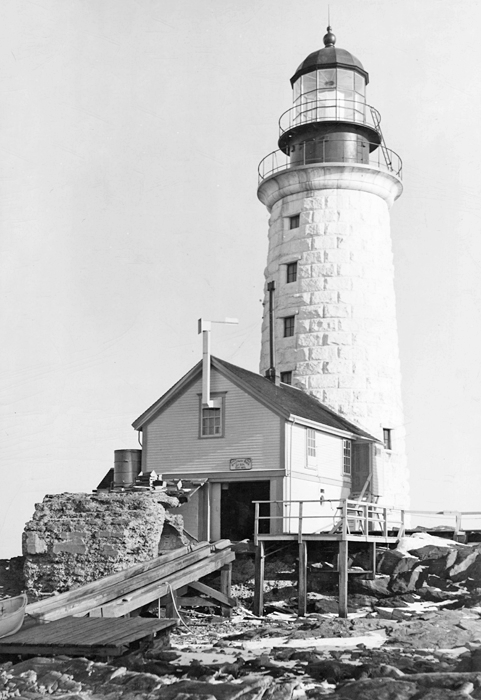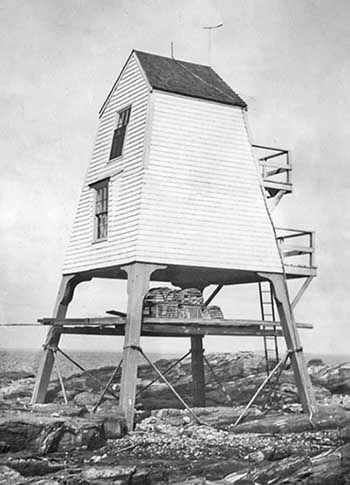Halfway Rock Lighthouse
Casco Bay, Maine - 1871 (1871**)

History of the Halfway Rock Lighthouse
Posted/Updated by Bryan Penberthy on 2016-11-28.
On a small ledge nearly ten miles offshore from Portland, Maine, stands the Halfway Rock Lighthouse. The name comes from its location, "halfway" between Cape Elizabeth and Cape Small, near Phippsburg in Casco Bay.
Although the Portland Head Lighthouse was established in 1791, and the Seguin Island Lighthouse was established in 1796, neither did much to mark the nearly two-acre rocky island, which is a little more than ten feet above sea level, in the middle of Casco Bay.
On a return from a trip to Providence, Rhode Island, the brig Samuel, under command of Captain George W. Small, was in Casco Bay during a southeast gale when it struck Halfway Rock around 10 p.m. on the night if June 19, 1835. Captain Small and another crew member had been washed overboard by a rogue wave and were lost. The rest of the crew sought refuge behind the ledges on the island, until their rescue the next morning.
The wreck of the Samuel, no doubt, started discussions of a lighthouse to mark the remote ledge. The first mention of marking the hazard came on May 9, 1837 when Captain Joseph Smith, U.S. Navy, had recommended the construction of a stone day mark as the ledge was hard to discern during foggy weather.
"Half-way rock" is situated nearly equally distant from Portland and Seguin lights; it is a landmark much used by coasters and others, and when made, there is no difficulty in shaping a course for a safe harbor. It is surrounded by deep water, and in the common passage of coasting vessels. In hazy or foggy weather, other rocks are sometimes mistaken for this, and when that is the case, disaster is the probable consequence...upon this rock I respectfully recommend the erection of a stone monument, and the cost of it I estimate at three thousand dollars.
It was mentioned again on November 16, 1838 in a report by Lieutenant Thomas J. Manning, U.S. Navy:
Halfway rock - This rock is about half way from Portland light to Seguin light, and immediately in the track of vessels bound from one of those places to the other; it is about sixteen feet above the level of the sea at high water; and I would recommend an iron "trivet" to be placed on it, with an iron basket on the top, that navigators may distinguish it from any other rock in thick weather; for, by distinguishing this rock, you can take your departure for several harbors. There are several rocks in-shore of the halfway rock that are frequently mistaken for it. Ships must, for their safety, make a harbor on this coast in thick weather.
A British bark, Boadicea, would strike Halfway Rock on February 12, 1861 without warning. All aboard were lost. Despite numerous documents and shipwrecks, no action was taken until 1868 when an entry appeared in the Report of the Secretary of the Treasury on the State of the Finances for the Year 1868 stating that an estimate of appropriation was submitted to Congress during its last session, but no appropriation was made. An updated request was resubmitted, and finally, in March 1869, Congress appropriated $50,000 for the construction of a lighthouse at Halfway Rock.
In July 1869, a work crew arrived at the island and started the process of leveling the rough rock surface for the tower's foundation. As the location was so remote, temporary quarters were constructed on the island to house the workers.
Two major storms that fall slowed down the progress, however, the foundation was completed by the end of 1869. Work was suspended for the winter, but picked back up in the spring of 1870. Granite was quarried from Chebeague Island and then prepared at Fort Scammel in Portland. After that, the blocks were sent to Halfway Rock.
On the 30th of June, 1870, the unused balance of the appropriation reverted to the Treasury, causing a work stoppage. At that point, the material and machinery were removed from the island and stored. During March 1871, Congress appropriated $10,000, which allowed construction of the tower to resume, however, there was now a labor shortage which delayed the project.
Workmen who had been building federal gunsites in the area were sent to Halfway Rock to complete the lighthouse. By summer 1871, the 76-foot granite tower was nearly complete. To ensure the tower's stability, the massive granite blocks were dovetailed together, a design similar to the Minot's Ledge Lighthouse in Massachusetts.
That same year, the Lighthouse Board had recommended the construction of a masonry boathouse and fog signal. The boathouse was completed in 1872, but no fog signal would be established until 1887.
As there was no dwelling on the island, the keepers had to live in the tower. The first floor of the tower was the kitchen. The second floor was the bedroom of the principal keeper. The third floor was a shared bedroom for the assistant keepers. And the fourth floor, just below the lantern, was a watch room, where the keeper on duty would remain throughout the night.
Captain John T. Sterling was hired as the station's first keeper. On the night of August 15, 1871, Sterling placed the light into service allowing a white light, punctuated by a red flash, to be exhibited from the third-order Fresnel lens. Two assistant keepers, James Jones and Albert F. Purrington, were assigned to the station. Two keepers were on duty at all times, the third would be on shore leave.
The isolation was enough to drive some keepers mad. One such keeper, George A. Toothaker, became the first assistant in 1873, a position he held until 1883. He was described as "bronzed and fissured even as the gray and seaweed-stained granite of the Rock itself." From 1883 to 1885, Toothaker was the principal keeper.
There would be weeks at a time when Toothaker wouldn't speak to his assistant, William T. Holbrook. When asked why, he said that he had nothing against Holbrook, he just didn't have anything to say. Although he was told to speak to the other keepers, he still refused to converse. Holbrook later told an inspector that Toothaker was "at times out of his mind, or on the verge of so being."
 Halfway Rock Lighthouse (Courtesy Coast Guard)
Halfway Rock Lighthouse (Courtesy Coast Guard)
There were two separate occasions that Toothaker suddenly abandoned his post, and rowed to his home in Harpswell, Maine, a distance of nine miles. Finally, Holbrook expressed a fear to the inspector that Toothaker might attack him. The inspector agreed, stating that Toothaker had "a natural tendency to insanity, which his lonely life on the Rock had aggravated."
The inspector convinced Toothaker to resign, at which time Holbrook was promoted to principal keeper. Even after being gone for years, Toothaker said he would still wake out of a deep sleep, worrying that the light had gone out.
During storms, the Atlantic Ocean would rise up and consume the island. In one such storm, on December 28, 1887, seas of 8 feet covered the island. That same year, the Halfway Rock Lighthouse received its first fog signal. The Annual Report of the Lighthouse Board documented it:
46. Halfway Rock, Casco Bay, Maine - A pyramidal, skeleton bell-tower, 43 feet high, was built of yellow pine timbers 10 inches square, heavily bolted to the ledge; 80 feet of plank walk, with rail, were laid to it from the light-tower, and a 1,000-pound bell, with striking machine, was provided and placed in operation.
In 1888, a new, two-story, 18-by-24-foot boathouse was built. The second story contained two additional rooms of living space, improving the living conditions at the station. To ensure it wouldn't be washed away, it was both bolted to the ledge, as well as to the tower. Despite this, the keepers most likely still sought refuge in the tower during storms.
Although the station was changed over to mineral oil in 1883, commonly called kerosene, an oil house wasn't added to the station until 1890. Due to the frequent storms that inundated the island, it had to be raised up. The Annual Report of the Lighthouse Board detailed its construction:
50. Half-way Rock, Casco Bay, Maine - A double boat-slip was formed by adding a third rail to the single boat-slip. A framed and shingled oil-house, 8 feet square, was built and secured 20 feet above the rock upon a pyramidal skeleton frame of 10-inch square yellow pine timber heavily bolted to the ledge. Minor repairs were made.
 Raised oil house (Courtesy Coast Guard)
Raised oil house (Courtesy Coast Guard)
Although a fog bell had been installed at the station since 1887, it was deemed inadequate in rough weather. It was replaced in 1905 with a first class Daboll trumpet, operated by a diesel engine.
The last civilian keeper was Arthur Strout, a descendant of the Strout Family, keepers associated with the Portland Head Lighthouse. Arthur was an assistant keeper from 1929 to 1934, at which time he was promoted to principal keeper.
When the U.S. Lighthouse Service was merged into the United States Coast Guard, Strout was given the choice to stay a civilian keeper, or join the Coast Guard. He chose the latter, and became the first Coast Guard keeper to serve at the Halfway Rock Lighthouse. His title was Officer in Charge of Halfway Rock, a position he held until 1945.
Keepers found ways to keep busy. Many would pass the time by reading or fishing. One keeper, Ken Rouleau happened across a seagull with an injured wing. He cared for the bird and nursing it back to health. Once strong enough, it flew away.
Another keeper, Stephen Krikorian, once found a basketball that washed ashore. Using a ballpoint pen, he outlined and counted all the pimples. During an interview with a reporter from the Portland Press, he said "There are 2,448 pimples on this. I counted 'em. It took a day."
During a storm in February 1972, the third-order Fresnel was damaged. A decision was made at that time to automate the Halfway Rock Lighthouse. It would take a few years, but the station was automated in 1975, setting the keepers free.
The historic Fresnel lens was replaced by a DCB-224 airport style beacon. Today, a modern, solar-powered optic provides the light. After being crated up, the lens was transported aboard the Coast Guard Cutter Eagle to the academy in New London, Connecticut, where it eventually was placed on display at the museum.
After automation, and over time, storms have destroyed the other structures that once stood on the island. Today, all that is left is the tower and the two-story boat house.
In the late 1990s, under the Maine Lights Program, the lighthouse was offered to any local nonprofit group. When no entity came forward, the American Lighthouse Foundation, in May 2000, licensed the tower from the Coast Guard.
On May 16, 2012, the Halfway Rock Lighthouse was made available by the General Services Administration under the National Historic Lighthouse Preservation Act of 2000. This act allowed the lighthouse to be transferred to any eligible federal, state, local, nonprofit, or educational institution to be used for education, recreation, or for historic preservation purposes.
When no entity came forward, the lighthouse was put up to auction on May 14, 2014. Six bidders spent several months trying to win the lighthouse, but when the auction ended, it was Ford Reiche's winning bid of $283,000 that took the Halfway Rock Lighthouse. This has been the highest dollar amount ever paid for a Maine Lighthouse.
Who is Ford Reiche and why is he doing it?
Reiche was the co-founder of Safe Handling, a transportation logistics company, which he has since sold. He is also a trustee of Maine Preservation, and has restored other historic properties in Western Maine. In the end, he says that it is something that needed to be done, and he has the skills and resources to do it.
Like the many keepers of the Halfway Rock Lighthouse before him, Reiche discovered how difficult getting to the tower is. He has already damaged two small skiffs and their motors beyond repair. Rather than give up, Reiche purchased a 25-foot Safe Boats International Defender-class vessel from a Coast Guard auction.
Reiche plans to restore the Halfway Rock Lighthouse and attached wooden boathouse to what they were like in the 1950s. So far, he has pulled the walls back to their Douglas fir paneling, which created a cozy kitchen and eating area. The space is warmed by a Queen Atlantic wood range.
While Reiche was in the process of removing a failing wall, he found an empty bottle of Cobbs Creek whiskey tucked inside the wall framing. It was signed by Arthur Strout and William Clark, and was dated "Xmas 1938", possibly protesting the imminent disbanding of the U.S. Lighthouse Service, which was set to take place in 1939. Alcohol was prohibited at lighthouses.
Most of the summer of 2015 was spent rebuilding the 150-foot boat dock and ramp. To that, he says "I have a healthy attitude about that dock. There's no way it could have been built stronger. But if it washes away, we'll build a new one."
Bob Trapani, executive director of the American lighthouse Foundation summed it up best: "Ford was its last hope, really. No one would be doing what he's doing. Thirty years from now, this will be seen as a historic moment."
Note: The lighthouse is private property, please respect this and do not trespass.
Reference:
- Annual Report of the Light House Board, U.S. Lighthouse Service, Various years.
- "Cumberland man works to restore his own private lighthouse," Tux Turkel, Portland Press Herald, July 10, 2016.
- "Endangered Halfway Rock Lighthouse is For Sale," Kathleen Finnegan, Lighthouse Digest, July / August 2014.
- "Ken Rouleau's Year at Halfway Rock," Jeremy D'Entremont, Lighthouse Digest, February 2003.
- "Bidding for lighthouse off Harpswell reaches nearly $250,000," Seth Koenig, Lighthouse Digest, September 2, 2014.
- "Restoration at Halfway Rock Reveals Evidence of Its Keepers," J. Candace Clifford, lighthousehistory.info, June 26, 2016.
- Lighthouses of Maine, Bill Caldwell, 1986.
Directions: This lighthouse sits about ten miles off shore from Portland, Maine. The only ways to view this lighthouse are via boat or air. Several cruise tours leave from Portland and pass by this lighthouse. That would be your best best.
Access:The lighthouse is privately owned. Grounds / tower closed.
View more Halfway Rock Lighthouse picturesTower Height: 76.00'
Focal Plane: 77'
Active Aid to Navigation: Yes
*Latitude: 43.65600 N
*Longitude: -70.03692 W
See this lighthouse on Google Maps.
